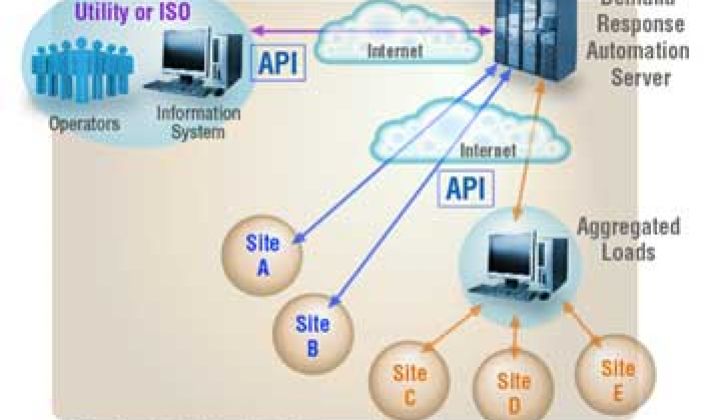If you have been following the OpenADR specification, you may have been waiting patiently for OpenADR-certified products to hit the market late last year. That didn’t happen -- but the OpenADR standard is evolving and certification for products is coming within the next two months.
Demand response is evolving on all fronts, including the markets in which it is authorized to compete and the ways it is delivered between facilities and the grid. The OpenADR (automated demand response) standard, which first emerged out of Lawrence Berkley National Laboratory, is one of the more active domain in demand response, with an alliance that claims some of demand response’s biggest players and no other competing standard in the rearview mirror.
“Finally, there’s a demand response standard and that was always missing,” said Barry Haaser, managing director of the OpenADR Alliance, the non-profit that seeks to increase the acceptance of the communication standard. “Buildings will need to ebb and flow with the price of electricity.”
The promise of OpenADR is that it will bring some certainty to the various grid operators and utilities across the country, and possibly the world. With that guarantee, customers and system operators would unlock far more megawatts then are available on the market today. Ideally, automated signals would allow homes and businesses to respond seamlessly to dynamic pricing.
But OpenADR 2.0 is squarely focused on the communications spec at this time. For the commercial market, only a fraction of all buildings actually have building management systems, and some companies may never relinquish control to utilities. One of the Alliance’s most prominent members, EnerNOC, is supportive, but actively questions the extent of the standard’s impact in the market.
“The major limitation is the customer's willingness to automate their facility,” said Gregg Dixon, senior vice president of marketing at EnerNOC. “Auto DR has its place, but you have to be very realistic about how it’s applied and its potential in the market.”
But with just a communication standard, Haaser thinks there will be plenty of progress. “What’s going to happen is you’ll see pretty significant incentives from utilities backed by PUCs for building owners to update their controls to allow them to participate in these programs,” he said. “Probably similar to the returns people will get being a part of aggregators today.”
Dixon argues that a majority of the megawatts for DR are in industrial and manufacturing, sectors that will never want to be fully automated. However, other companies, like Powerit Solutions, are using OpenADR to do just that. EnerNOC is not the only voice of moderation (or dissent, depending on your take), and many in the industry feel that OpenADR has a long way to go, or at least won't be the panacea that many would like it to be.
In its current iteration, it is comprised of three separate communications standards, OpenADR A, B and C, which specify communication to simple devices (thermostats, residential gateways), building automation systems and communications back to ISO and aggregators for more complex market interactions, respectively. It does not track whether load is actually dropped, nor does it continuously optimize the load based on weather.
In other words, it’s still early days, but it’s a huge step in the right direction.
Even though most of that load could be dimming lights or tweaking HVAC, if huge markets could be unlocked outside of commercial load, the peak shaving could be significant. But that is still a big 'if,' as automation is just one piece of unlocking those markets.
EnerNOC’s Dixon argues that OpenADR will not make much of a difference on the C&I front, because only a small proportion of the structures in the commercial market have a building management system, and those with the largest industrial loads, as well as those with sensitive loads (such as government buildings), tend to want to remain in control.
But the standard extends to devices such as smart thermostats, which could start to standardize the market for small commercial and potentially even residential, especially if dynamic pricing is widely offered in coming years. Haaser noted that the first pilots of utilities using this for residential loads will come this summer.
In a demand response report from 2009, the Federal Energy Regulatory Commission found the best-case scenario for DR could be as much as 188 gigawatts by 2020. “Although FERC never mentions it, it would make sense that smart grid standards, like the OpenADR specification, may be an aspect of this best-case scenario,” said Marianne Hedin, an analyst for Pike Research who recently wrote a report about automated demand response.
The 70-plus members of the OpenADR Alliance show that even though many members are wary of what the standard can accomplish, everyone is on board to put in their two cents. Currently, there is no other alternative in the U.S. or worldwide. One of the alliance’s missions is not to just get OpenADR to be a U.S. standard, but to make it an international standard for demand response.
Although the 2.0 standard leaves a lot to be desired, especially in confirming load shed, it could help to expand the conversation with regulators and market operators about the role demand response will play. “I suspect regulators will rapidly become a priority audience as soon as we have [a technical specification] that is published,” said Haaser.
Ultimately, it will not be a matter of whether OpenADR can unlock more megawatts, but whether it will evolve in conjunction with other market and technological changes to transform how buildings consume energy.



